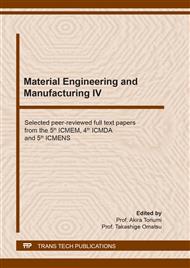p.103
p.109
p.116
p.125
p.133
p.139
p.145
p.151
p.159
Fabrication and Measurement of Flexible Polymer Aerogel and Factors Affecting its Thermal Conductivity
Abstract:
Silica aerogels are the most widely studied type of aerogel. However, its application still suffers from low mechanical strength and high production cost. The paper studies the use of recyclable PVC as the backbone material of the aerogel and introduces an economically friendly fabrication process of flexible PVC aerogel using sol-gel technique and ambient drying instead of the CO2 critical drying. Three different types of PVC powder with the molecule weight of 43000, 48000, and 80000 respectively are chosen and dissolved in DMF in five different concentrations-0.2, 0.4, 0.6, 0.8, and 1.0 g (mL)-1. The lowest thermal conductivity of the aerogel is measured using hot-wire method as 0.0323W(m*K)-1, which is made of PVC with molecule weight of 80000 in a concentration of 0.4g (mL)-1. The analysis based on SEM pictures shows that PVC type and concentration would greatly influence aerogel’s structure thus affecting its thermal conductivity. The optimal solution for producing low thermal conductivity aerogel is to use PVC powder with low molecule weight with a concentration between 0.2 and 0.6 g (mL)-1.
Info:
Periodical:
Pages:
133-138
Citation:
Online since:
September 2021
Authors:
Keywords:
Price:
Сopyright:
© 2021 Trans Tech Publications Ltd. All Rights Reserved
Share:
Citation:


